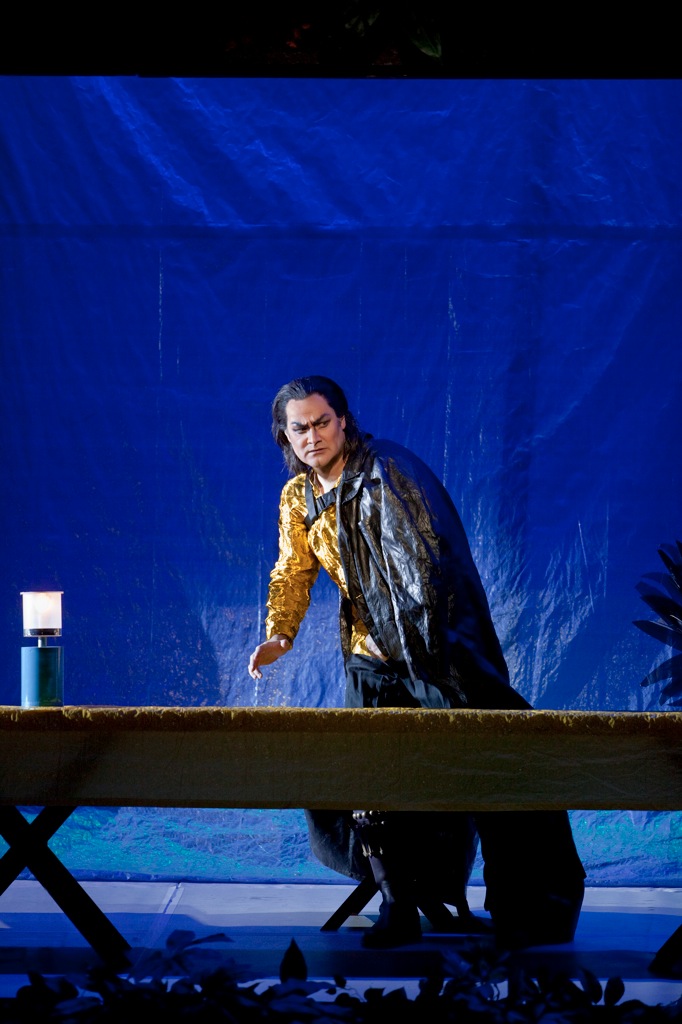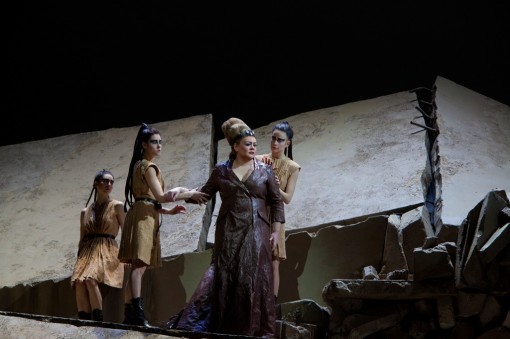Muti commanding in Met return while static staging highlights “Attila” weaknesses
The premiere of the Metropolitan Opera’s new production of Verdi’s Attila last Tuesday generated several important company debuts, including that of the opera itself. There was also a starry, entirely new production team consisting of the distinguished director Pierre Audi and the architectural partners Jacques Herzog and Pierre de Meuron (Tate Modern, Beijing National Stadium), who collaborated with the celebrated fashion designer Miuccia Prada on the sets and costumes. Yet there was no secret about the debutant foremost on people’s minds: The presence of Riccardo Muti in the pit was what packed the house and gave the evening a buzz.
Despite Muti’s preeminence in the symphonic repertoire—which rightly has Chicagoans salivating as he prepares to assume the music directorship of the Chicago Symphony next season—hearing him conduct Verdi is a transformational experience. We all know that Verdi is a great composer, but in the humdrum of everyday operatic life he doesn’t always sound like a great composer.
Muti consistently ensures that he does so by giving every note its due. For him, no accompaniment figure is too banal, no rhythm too earthy to contribute to an opera’s overall expressive force. Singers are likewise expected to believe in the integrity of the music and avoid indulgences like unwanted interpolated high notes. You knew that the Met audience understood it was hearing something special from the rapt attention with which it followed the proceedings—from the brooding orchestral preludes or the arresting instrumental depiction of a sunrise, all which were cogently shaped, to the rousing quick numbers,which always had plenty of drive.
But even Muti’s magic could not disguise the weaknesses of Attila. Qualitatively speaking, this early work ranks somewhere towards the middle of the pre-Rigoletto operas. It lacks the vibrant characters of Ernani, is less interesting than I due Foscari and psychologically falls well short of Macbeth (even in that opera’s original version).
Attila is strong on blood-and-thunder elements, which is hardly inappropriate given that its protagonist is Attila the Hun. The opera’s most striking scene comes when Attila is confronted by bishop Leone at the gates of Rome, an event that Attila prefigures in a dream and that brings to the fore cultural and religious clashes. Near the end of the opera there is a stirring trio in which the Roman principals plan Attila’s demise, although the subsequent implementation of their plan makes for a dramatically feeble close.
It all left one suspecting that Muti’s vaunted abilities would have been enlisted to better effect on behalf of a stronger, more familiar Verdi opera—take your pick. Still, he upheld his responsibilities with the utmost distinction.
Audi and his production team seemed less sure of themselves. Audi took an unusually static approach that emphasized tableaux. As if to point up the thoroughness of Attila’s destruction, the set consisted initially of a heap of cement-slab ruins, akin to modern-day Haiti. It looked dangerous for the principals to negotiate physically. In fact, the sets almost seemed designed to impede normal stage movements. The chorus, stationed on the stage floor below (occasionally with their legs in a ditch), had an easier time of it, and sometimes the main characters were allowed there as well.
This bi-level approach continued throughout the opera, often enhanced by Jean Kalman’s imaginative lighting. But after the Prologue the cement slabs gave way to dense foliage made up of gigantic plants, reminiscent of an Amazon jungle. Since “Attila” deals tangentially with the founding of Venice, perhaps the plant life was meant to represent the primeval terrain that antedated the city; if not, I haven’t a clue. The sets went through relatively minor changes (effectuated behind a lowered curtain), which sometimes allowed for clearings high up in the foliage through which singers—notably Attila and the Roman general Ezio—appeared. The effect reminded me of Klingsor in his magic garden, and, in fact, in a program note Audi alluded to Wagnerian parallels. Clearly he was looking for deeper levels of meaning. But much of the opera’s vigor was exchanged for questionable interpretive insights. The much touted costumes were essentially traditional but incorporated interestingly creative details.
Violeta Urmana began life as a mezzo and made the transition to dramatic soprano several years ago with remarkable ease. A highly valued artist, she showed she has ample wherewithal for the punishing role of the warrior-maiden Odabella, who ingratiates herself with Attila to gain the opportunity to murder him. But Urmana’s high notes sounded distressingly acidic, even allowing for the difficulty of delivering the daunting aria Allor che i forti corrono so soon into the opera.
The fine young bass Ildar Abdrazakov gave a vibrant, dramatically convincing portrayal of Attila. And we know him to have a voice of greater heft than was apparent here. I suspect he would have sounded better if he were not so often positioned high above the stage and if he had the benefit of sets more helpful acoustically.
Ramón Vargas offered highly accomplished singing as the Aquileian knight Foresto and interestingly decorated the repeat of his cabaletta Cara patria, già madre. His phrasing was always admirable but the voice lacks the ideal liquid resonance for a mainstream Verdi tenor role. Baritone Giovanni Meoni, replacing an indisposed Carlos Alvarez, made an notable debut as Ezio. He displayed a handsome, not overly plush but distinctively Italianate voice; and as the one Italian in the cast, he sang with the best diction. In an appealing casting detail, Samuel Ramey, a formidable Attila in years past, lent his still authoritative if wobbly bass voice to the brief role of Leone.
Attila runs through March 27. The last three performances will be conducted by Marco Armiliato. http://www.metoperafamily.org/metopera/


Posted Mar 03, 2010 at 7:10 am by Kostas
This video featuring Muti and La Scala forces was gorgeously produced by Jérôme Savary and remains
infinitesimally superior to the Pierre Audi embarrassment at the
Met. And so is the cast of singers, infinitesimally superior to the Met’s.
http://www.amazon.com/Verdi-Attila-Zancanaro-Kaludov-Gavazzi/dp/B00066K2R4/ref=sr_1_2?ie=UTF8&s=music&qid=1267572978&sr=1-2
Posted Mar 03, 2010 at 9:19 am by Jamesay
Positive comments = Singing acceptable and conducting superb (in the main! Bravi)
Sets – looked “interesting” as sculptures but offered NOTHING in the way of stagecraft or space to play each scene – A MESS !
Costumes – barely resembled what we saw in the designs (clearly designed for stick insects and worn by heavy set people. Camp but not meaningful)
Production – last scene reduced to soloists (NONE of whom could act – esp Attila who seemed to walk in time to the music) wandering about on a black floor, with a blackout curtain behind them…. NO STAGECRAFT from Director….. A real TURKEY.
SHAME on the management for not putting a stop to this money losing MESS.